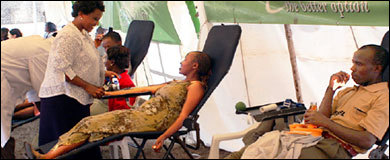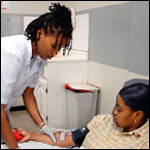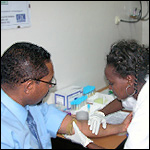Blood Supply: Improving Safety in the Caribbean and Africa
 In recognition of World AIDS Day, CDC.gov is highlighting the progress made by 14 CDC-supported African and Caribbean nations toward delivering an adequate supply of safe blood.
In recognition of World AIDS Day, CDC.gov is highlighting the progress made by 14 CDC-supported African and Caribbean nations toward delivering an adequate supply of safe blood.
 Through the President's Emergency Plan for AIDS Relief (PEPFAR), CDC works in partnership with countries to strengthen laboratory capacity, epidemiology, surveillance, public health evaluation, workforce capacity, and prevention initiatives—essential components for strong sustainable public health systems.
Through the President's Emergency Plan for AIDS Relief (PEPFAR), CDC works in partnership with countries to strengthen laboratory capacity, epidemiology, surveillance, public health evaluation, workforce capacity, and prevention initiatives—essential components for strong sustainable public health systems.
A key part of CDC's health systems strengthening activities has been four years of support to improve national blood transfusion services in 14 countries in Africa and the Caribbean, including: Botswana, Cote d'Ivoire, Ethiopia, Guyana, Haiti, Kenya, Mozambique, Namibia, Nigeria, Rwanda, South Africa, Tanzania, Uganda, and Zambia. This support has included needs assessments, strategic planning, development of guidelines and training materials for volunteer donor recruitment, possessing and rational clinical use of blood, assistance procuring vitally needed commodities such as testing kits, and monitoring and evaluation.
Over the past five years, these 14 countries have substantially increased total blood collections from low-risk, voluntary, unpaid donors; strengthened laboratory capacity to ensure that all collected units are screened for HIV and other transfusion-transmissible infections; and seen a decrease in the prevalence of HIV-infected units.
Success Stories

In 2003, the Kenyan National Blood Transfusion Service (KNBTS) was able to provide only about 20 percent of the country’s estimated demand for blood. Since then, with PEPFAR support, KNBTS annual blood collections have increased six-fold. Today, more than 140 of the 181 Kenyan hospitals that transfuse blood get 80 percent of their blood supply from the national blood service.
In Haiti, only 5 percent of blood came from voluntary donors in 2004. By 2007, the proportion of blood collected from low-risk, voluntary, unpaid donors had increased to 64 percent. With PEPFAR support, Haiti’s national blood service has also increased total annual collections from fewer than 8,000 units to nearly 20,000 units.
World AIDS Day 2008
 This year's World AIDS Day coincides with the passage of the reauthorization of the PEPFAR legislation, which President Bush signed into law on July 30, 2008.
This year's World AIDS Day coincides with the passage of the reauthorization of the PEPFAR legislation, which President Bush signed into law on July 30, 2008.
The act reaffirms the US commitment to the global fight against HIV/AIDS, and outlines prevention, care and treatment objectives for PEPFAR for the next five years. CDC has leveraged the agency's core strengths to make unique contributions to PEPFAR, like these blood safety activities, and CDC looks forward to helping the U.S. Government meet PEPFAR's new 10-year goals: treatment for at least 3 million people, the prevention of 12 million new infections, and care for 12 million people, including 5 million orphans and vulnerable children.
More Information
- Progress toward Strengthening Blood Transfusion Services—14 Countries, 2003-2007 (Morbidity and Mortality Weekly Report.. November 28, 2008 / 57(47);1273-7))
- World AIDS Day Feature
- CDC Global AIDS Program
- PEPFAR
- HIV/AIDS FAQ: How safe is the blood supply in the United States?


